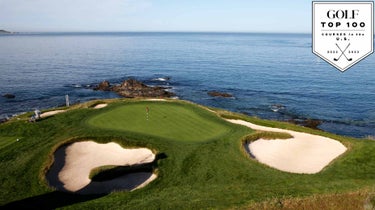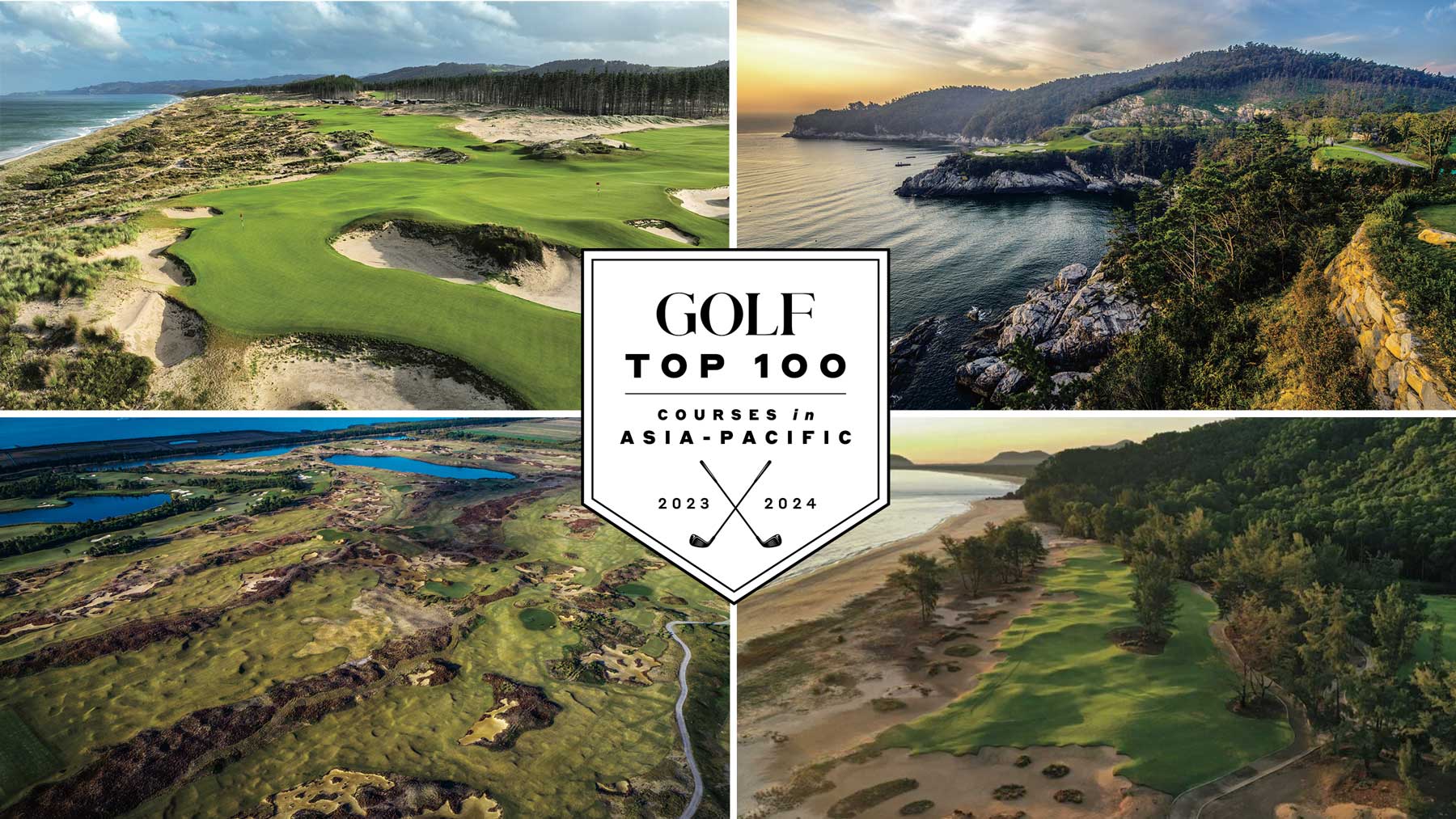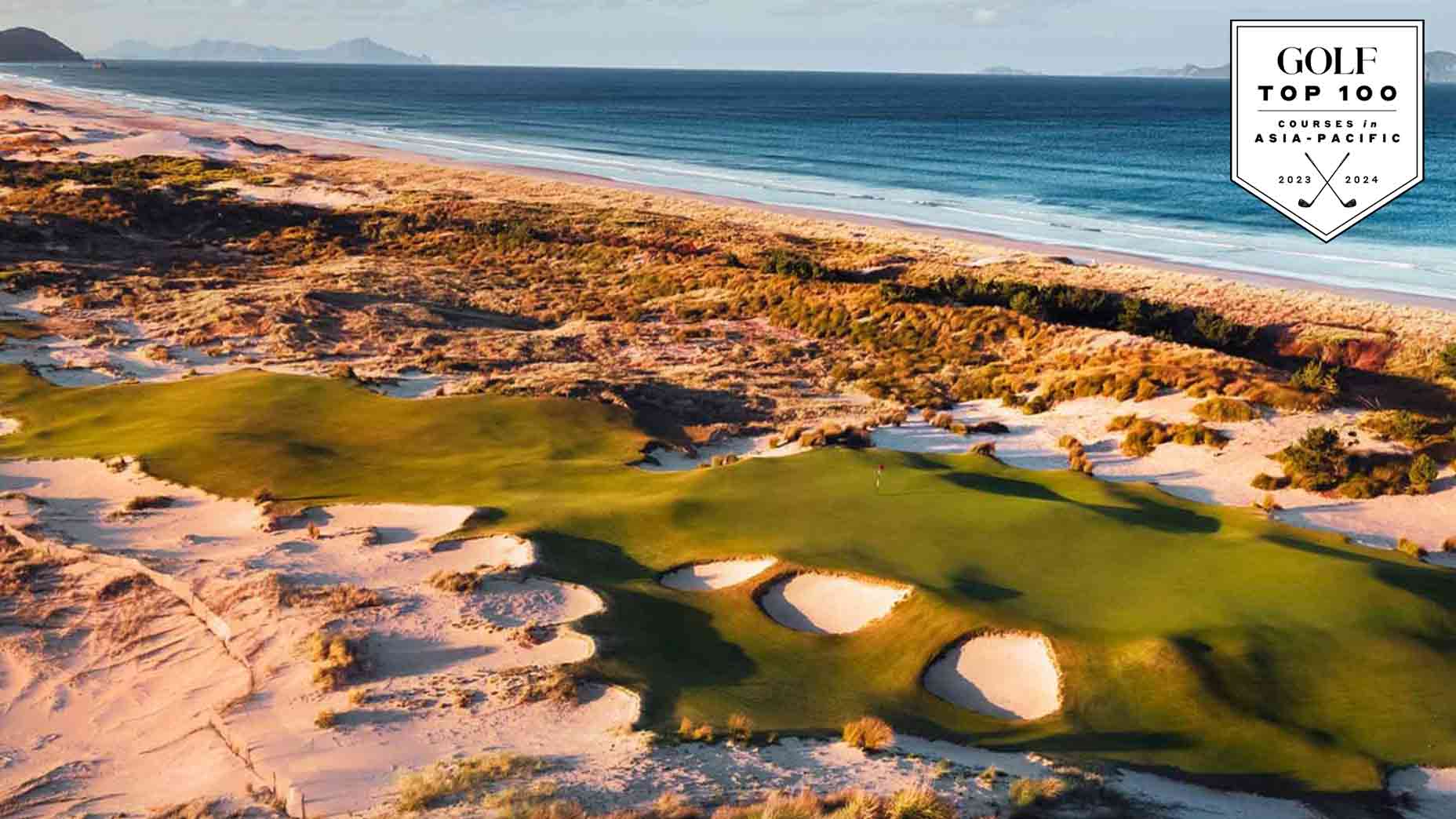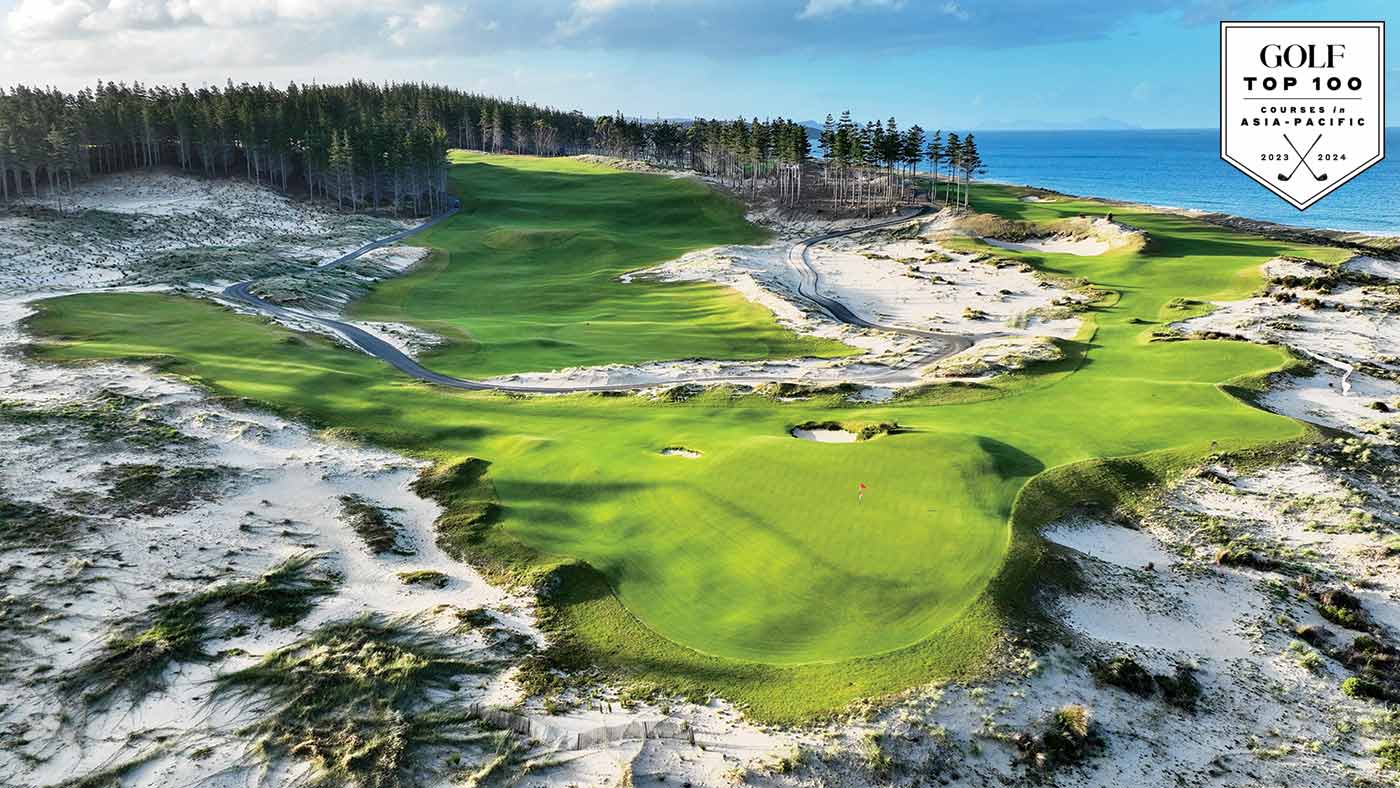
Te Arai (South) in Tomarata, New Zealand, a 2022 Bill Coore and Ben Crenshaw design.
Gary Lisbon
GOLF Magazine‘s inaugural ranking of the finest courses in Asia-Pacific is long overdue. Not only does the region boast an eclectic mix of architecture, but it’s also home to some of the finest designs built this century. To say the course-building business in the lands where the sun rises first is booming would be an understatement.
Australia scored big, placing 38 courses in our ranking. And no surprise that the West Course at Royal Melbourne finished in the top spot — it has, after all, held the top spot in the Southern Hemisphere ever since we started publishing world rankings four decades ago. That said, its margin of victory over Kingston Heath (No. 2), a world-class course in its own right, was impressive, as it finished more than six points (!) higher than its Aussie counterpart. To put that in perspective, Pine Valley, in our latest ranking of Top 100 Courses in the U.S., beat out runner-up Cypress Point by less than two points.
More GOLF course rankings: Top 100 Courses in the World | Top 100 Courses in the U.S. | Top 100 Courses You Can Play | Top 100 Value Courses in the U.S. | America’s Best Municipal Courses | Top 100 Courses in the U.K. and Ireland | Top 100 Short Courses in the World
Regardless of whatever metrics you value when judging design, Royal Melbourne nails it. Like Shinnecock Hills, Melbourne’s closest equivalent here in the States, it’s a marvel for how effortlessly it flows across its landscape. The gift of time is a luxury rarely afforded modern architects, but it allowed Royal Melbourne, carved out over several years using “horse-drawn plough and scoop,” to emerge harmoniously from its sandy, scrubby environs. It’s the rarest of rare: a course with no faults.
Six courses in Oz made the top 10. Royal Melbourne, Kingston Heath, the East Course at Royal Melbourne (No. 8) and Victoria (No. 9) all are in Australia’s famed Sandbelt region. For those who like to travel to great courses that are clustered together, there are few — if any — better areas in the world to head to than here.
Such was the experience of GOLF panelist Pete Phipps, a North Carolina resident who made his first trip to Australia and New Zealand in January of this year. He toured 15 courses in 12 days. In addition to noting how the architects had taken full advantage of the region’s sandy soil, he came away mightily impressed by Australia’s golf culture, writing, “You go days without seeing a cart. You can carry your own bag everywhere, though most members prefer a trolley. The pace of play is steady. The clubhouses and locker rooms are done with great taste. While the Sandbelt courses show off amazing architecture and history, they do it without the pretentiousness or stuffiness that you experience at elite clubs in other countries.”
Having lived in Australia for six years, I fully agree with Pete’s glowing assessment. Back then, most weekends at my home club of Newcastle GC (No. 29), two hours north of Sydney, we played the Stableford format, a scoring system that keeps play moving at a fine pace. Trust me: There’s a commonsense approach to golf in Australia you don’t often see. Although it may take a 13-hour flight to get there, a trip Down Under is worth the effort for the complete playing experience.
The Land of the Rising Sun
Japan had the second most courses in our Top 100 ranking with 15. Its Big Five — Hirono (No. 4), the Fuji Course at Kawana (No. 6), Tokyo GC (No. 19), Naruo (No. 21) and the West Course at Yokohama (No. 26) — are the cornerstone for one of the game’s epic trips. True, you need to take a bullet train southwest to Osaka to play Hirono and Naruo and south from Tokyo to enjoy Kawana, but time, like the train, flies.
Similar to Australia, where Alister MacKenzie played such an outsize role in defining what constitutes great architecture, another Brit, C.H. Alison, played a pivotal role in the 1930s in shaping golf in Japan. His works at the country’s two best courses (Hirono and Kawana) influenced future Japanese architects such as Koymo Ohtani, who went on to build today’s version of Tokyo GC. Gil Hanse and Neil Cameron’s fantastic renovations at Tokyo a few years ago included work on the course’s famous greens. There are two per hole, originally one with warm-weather grass and the other built to survive in cooler temps. Advances in agronomy over the past 80 years has rendered this approach moot. The two-green model remains at Tokyo GC, asking wildly different — and fun — questions of the player.

Courtesy Photo
Kiwi Kindness
Alex Russell, the famed Australian architect who assisted Alister MacKenzie at Royal Melbourne before building other gems of his own, designed Paraparaumu Beach (No. 17) in 1948, which held the mantle as New Zealand’s finest course throughout the last century. It remains a delight, played over some of the game’s most lusciously rumpled land. And with a green fee of $120, it’s a fabulous bargain.
Drive 100 miles north from Paraparaumu up the west coast and you’ll find Waverley GC (No. 82). An honesty box is sometimes the only option you have for paying the roughly $20 green fee. Known colloquially as a “country course,” its greens crew includes sheep that roam the jumbled landforms. “Turf heads,” focused mainly on perfectly manicured conditions, need not visit, but for those who view small-town golf as integral to the fabric of the sport, Waverley is a reaffirmation that golf need not be expensive to be exhilarating.
Elsewhere on the North Island, two American business titans, Julian Robertson and Ric Kayne, have put New Zealand front and center for the best golf built this century. Kauri Cliffs (No. 34), which opened in 2000, is as pretty a setting as I’ve ever seen. Robertson quickly followed its success with Tom Doak’s Cape Kidnappers (No. 11) in 2004, where holes cling to the cliffs some 460 feet above the Pacific.
More GOLF course rankings: Top 100 Courses in the World | Top 100 Courses in the U.S. | Top 100 Courses You Can Play | Top 100 Value Courses in the U.S. | America’s Best Municipal Courses | Top 100 Courses in the U.K. and Ireland | Top 100 Short Courses in the World
Like Robertson, Kayne became bewitched by New Zealand’s impossible beauty and had Tom Doak build Tara Iti (No. 3) in 2015. Pictures of its green fairways twisting through white, sandy dunes instantly captivated golfers worldwide. New Zealand’s seasons are reversed from North America’s, meaning that when you poke your nose out and see nothing but snow in January in Minneapolis, the allure of Tara Iti, bathed in bright sunshine and warmth, becomes especially acute.
Given Tara Iti’s resounding success, Kayne subsequently hired Bill Coore and Ben Crenshaw — and Doak again — to build a pair of public-access courses four miles south down the coast from the private Tara Iti. The Doak course opens in October but the Coore & Crenshaw’s Te Arai South (No. 7) opened last year to rave reviews. Based on its finish here, we expect it to be a strong contender for inclusion in our 2023 World Top 100 due out in November.

jacob sjoman
In Other Parts of Asia
While Australia, Japan and New Zealand courses comprise nearly two thirds of our ranking, exciting builds are percolating all across Asia. Vietnam’s coastline, in particular, is being put to fantastic use. Panelist Paul Rudovsky, who has played over 1,500 courses, was smitten by his time in Vietnam and its people. Rudovsky is our resident course statistician and, citing a study by the R&A, writes, “Vietnam has grown from 78 courses in 2018 to 86 in 2020, and there are an additional 27 new courses that will have opened by year end 2025. So in seven years, Vietnam is projected to go from 78 to 113 courses— a growth of 45 percent!”
Similar to Paul’s sentiments on the Vietnamese, I was mightily impressed on my one visit to South Korea. For sure, Koreans embrace golf almost spiritually. You can see it in how neatly they present their courses and work with nature. Though we only rank courses themselves, if you’re into design in general, the architecture of the clubhouses at the finest courses in South Korea, including Nine Bridges (No. 12), South Cape (No. 14) and Whistling Rock (No. 37), will knock your socks off.
Course construction in China is a bit different — it tends to ebb and flow with the government’s desires. At the pinnacle stands Coore & Crenshaw’s Shanqin Bay on the island of Hainan. While its original 17th hole — one of the best on property — was removed a few years ago, a permanent replacement has now taken hold. The addition helped this coastal stunner move into 13th place on our list.
In terms of genuine outpost golf, try Himalayan GC (No. 23) in Nepal. Major Ram Gurung, a Gurkha who served in the British Army for 30 years, designed it in 1994. As he told my brother, “My main theme when laying out the course was simply to flow with nature and where possible bring into play a golfer’s senses by the sound and sight of rivers and canyon edges.” The roar of the Bijayapur River that runs through the canyon is thunderous as it carries snowmelt from the Annapurna range from several hundred feet above on the rim of the canyon. Take care when crossing this river in several spots — this is “adventure golf” of the highest order.
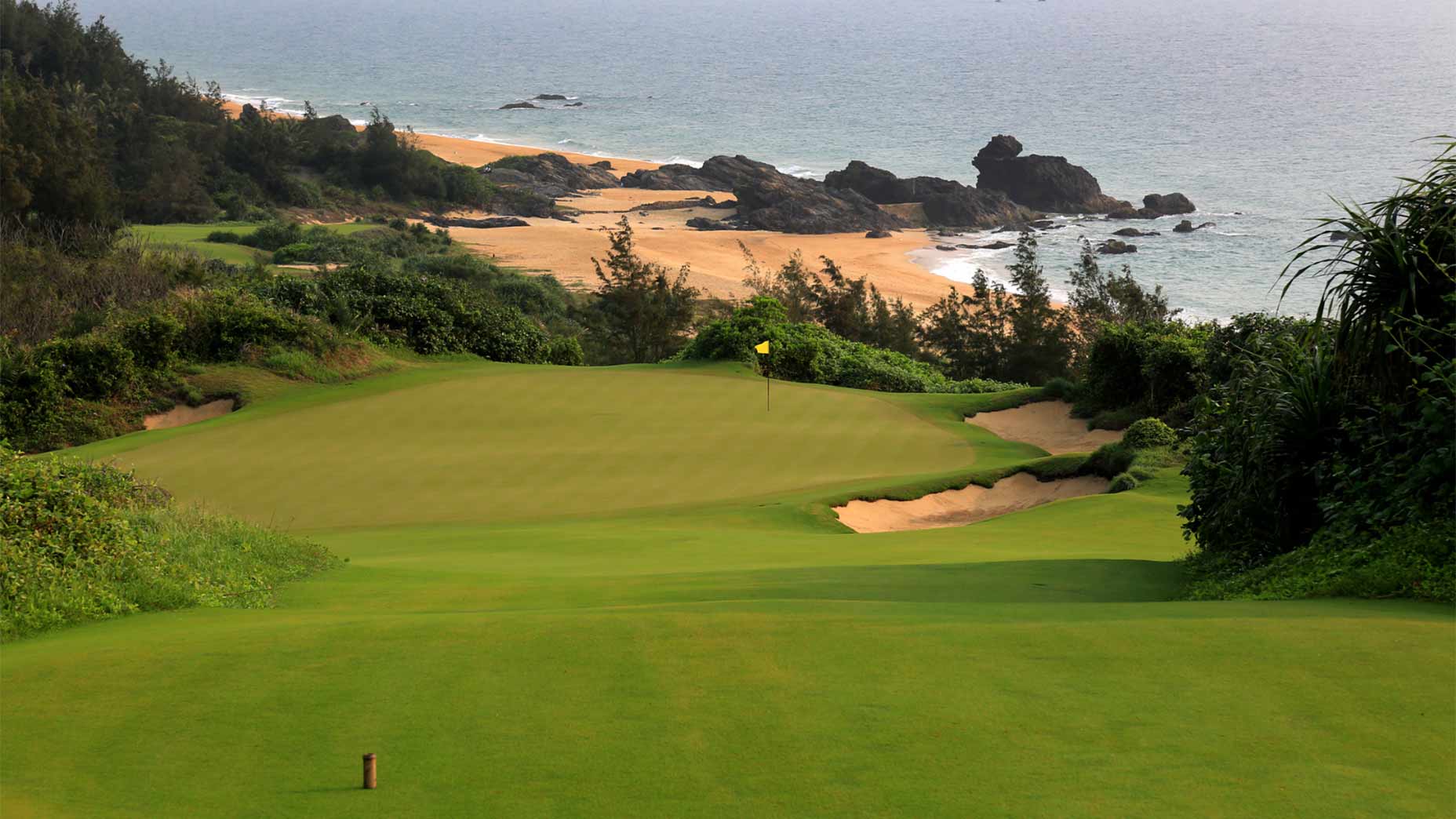
Gary Lisbon
The More Things Change…
As in the States, titans of architecture — from Alister MacKenzie to C.H. Alison to Tom Doak, Jack Nicklaus, Coore & Crenshaw — dominate this ranking. To appreciate the global design empire that Jack Nicklaus built over six decades, 10 original designs are featured here, the most by any architect. Aussie Mike Clayton (with varied partners) and Arizona-based Brian Curley (who has flown across the Pacific more than 500 times) are two other architects found frequently throughout this ranking.
Restorations, like our titans, play a big role in this ranking too. MacKenzie’s and Ebert’s work at Hirono directly led to its top-five finish, and the West Course at Yokohama might have been a hundred spots lower if not for what Coore & Crenshaw did there in 2015. MacKenzie’s Titirangi (No. 52) has been allowed to open up and breathe thanks to work by Clyde Johnson.
As evidenced by the photographs on these pages, Asia-Pacific is a gorgeous part of the world and its golf offerings are as diverse as its landscape. Talented architects have been taking advantage of what’s here for the better part of a century. You need to as well.
The ease of modern travel makes this region more attainable than ever. We trust that this ranking will help with future trips. Akin to golf in the United Kingdom, a proper letter of introduction gains you access to a majority of the region’s finest courses, which makes this ranking even more meaningful and practical. It’s a long flight, but you’ll return with lifetime memories. What are you waiting for?


